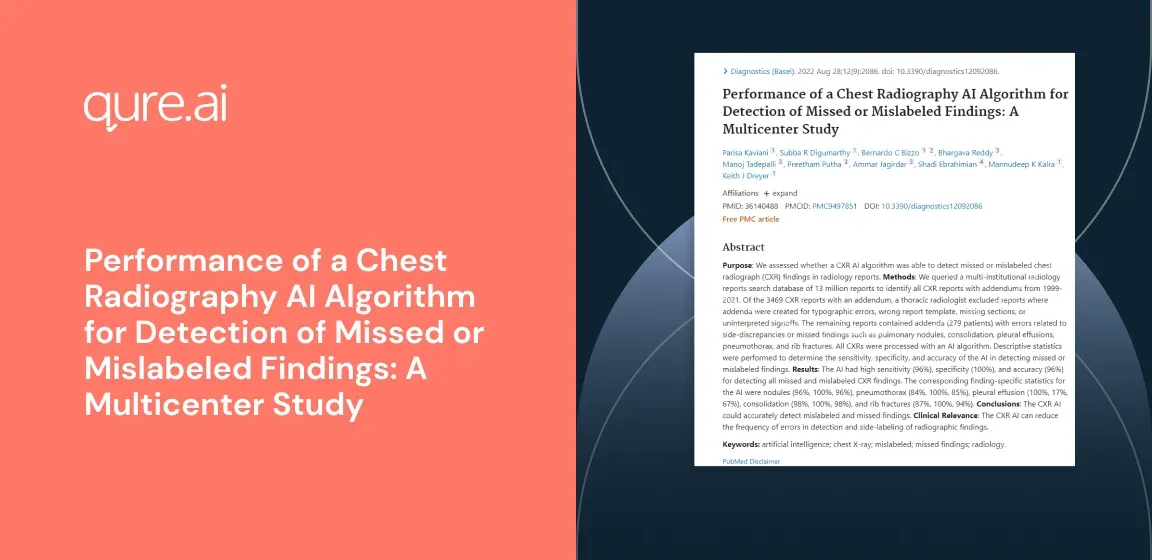BACKGROUND
Published 16 Nov 2022
Performance of a Chest Radiography AI Algorithm for Detection of Missed or Mislabeled Findings: A Multicenter Study
Author: Parisa Kaviani Subba R. Digumarthy Bernardo C. Bizzo Bhargava Reddy Manoj Tadepalli Preetham Putha Ammar Jagirdar Shadi Ebrahimian Mannudeep K. Kalra and Keith J. Dreyer

Back
According to studies, around 25% of annual diagnostic imaging procedures are for chest X-rays (CXRs). CXRs make up to almost half (44%) of all radiography pictures in the United States alone. Its broad usage in medical practice for a variety of cardiothoracic conditions can be attributed to several aspects, including ease of accessibility, mobility, familiarity, and price (compared to other imaging tests).
CXRs do, however, have a significant misinterpretation rate—up to 30%. In fact, according to earlier investigations, inter-radiologist and physician concordance for CXRs was as low as 78%.
Missed radiography findings can have serious consequences. For instance, take this other study that demonstrates that 19% of lung tumors that appeared as pulmonary nodules on CXRs were overlooked. Such overlooked results may be fatal for both patients.
OBJECTIVE
The goal of this multi-center study was to find out whether a CXR AI algorithm can spot overlooked or mis-labeled CXR findings in radiology reports.
This study took into consideration multi-institutional radiology databases totaling 13 million reports to identify all CXR reports for the past 22 years. The data was collected from centers such as the Massachusetts General Hospital (MGH), Brigham Women Hospital (BWH), Faulkner Health Center (FH), Martha’s Vineyard Hospital (MVH), Salem Hospital (NSMC), Newton-Wellesley Hospital (NWH), and Spaulding Rehabilitation Hospital (SRH).
STUDY DETAILS
The study’s primary application relates to the functionality and practical application of Qure’s CXR AI – qXR . A team of expert radiologists used Qure.ai’s CE- approved qXR for this retrospective multi-center study. It was used to investigate if qXR can reduce the frequency of errors in detection and side-labeling of radiographic findings.
STUDY HIGHLIGHTS
- The study included 279 CXRs with an addendum for missed/mislabeling from multiple sites in the US.
- ~90% of the missed/mislabeled CXR have been identified with a critical abnormality by qXR with zero false positives
- The study concluded that qXR could identify critical findings on Chest X-Rays, including malignant nodules.
CONCLUSION
The qXR AI algorithm had high sensitivity (96%), specificity (100%), and accuracy (96%) for detecting all missed and mislabeled CXR findings. The AI could accurately detect mislabeled and missed findings. Qure’s qXR can reduce the frequency of errors in detection and side-labeling of radiographic findings.
Authors
Parisa Kaviani Subba R. Digumarthy Bernardo C. Bizzo Bhargava Reddy Manoj Tadepalli Preetham Putha Ammar Jagirdar Shadi Ebrahimian Mannudeep K. Kalra and Keith J. Dreyer
Citation
1. Massachusetts General Hospital; MGH & BWH Center for Clinical Data Science; Internal Medicine-Icahn School of Medicine at Mount Sinai- Elmhurst Hospital Center